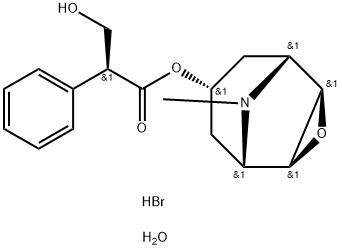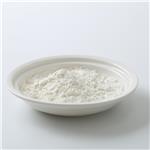Scopolamine hydrobromide is a bronchodilator indicated for the maintenance treatment of chronic obstructive pulmonary disease (COPD), including chronic bronchitis and emphysema, the maintenance treatment of concomitant dyspnea and the prevention of acute exacerbations.
Scopolamine is a nasal decongestant and adrenergic agonist that is used to dilate the pupil, reduce eye focusing ability, control saliva and gastric acid production, slow intestinal movements, and prevent vomiting.
ChEBI: Scopolamine hydrobromide trihydrate is a hydrate that is the trihydrate form of scopolamine hydrobromide. It has a role as a mydriatic agent, a muscarinic antagonist, an anaesthesia adjuvant, an antispasmodic drug and an antiemetic. It contains a scopolamine hydrobromide (anhydrous).
Isopto Hyoscine (Alcon); Transderm-Scop (Ciba-Geigy).
White orthorhombic sphenoidal crystals from water. pH of 0.05 molar solution: 5.85.
Is sensitive to air, light and moisture. Slightly efflorescent in dry air.
SCOPOLAMINE HYDROBROMIDE TRIHYDRATE is incompatible with acids, bases and oxidizing agents. .
Flash point data for SCOPOLAMINE HYDROBROMIDE TRIHYDRATE are not available. SCOPOLAMINE HYDROBROMIDE TRIHYDRATE is probably combustible.
Scopolamine Hydrobromide[6533-68-2] is a Belladonna Alkaloid with Anticholinergic Activity. It competitively inhibits muscarinic receptors of the parasympathetic nervous system for acetylcholine and act as a nonselective muscarinic antagonist, producing peripheral anti-muscarinic, central sedative and antiemetic effects. The parasympatholytic scopolamine, structurally very similar to atropine as well, is used in conditions requiring decreased parasympathetic activity. Therefore, scopolamine can inhibit the secretion of saliva and sweat, decrease gastrointestinal secretions and motility, and increase heart rate et al.
[1] KLINKENBERGINGE BloklandArjan. The validity of scopolamine as a pharmacological model for cognitive impairment: a review of animal behavioral studies.[J]. Neuroscience and Biobehavioral Reviews, 2010. DOI:
10.1016/j.neubiorev.2010.04.001.
[2] CEYHAN T, KARTAL M, ALTUN M L, et al. LC determination of atropine sulfate and scopolamine hydrobromide in pharmaceuticals.[J]. Journal of pharmaceutical and biomedical analysis, 2001, 25 3-4: 399-406. DOI:
10.1016/S0731-7085(00)00514-8.
[3] STEENKAMPP A. Fatal Datura poisoning: identification of atropine and scopolamine by high performance liquid chromatography/photodiode array/mass spectrometry.[J]. Forensic science international, 2004. DOI:
10.1016/j.forsciint.2004.03.011.
[4] MUHTADI F J, HASSAN M M A. Analytical Profile Of Scopolamine Hydrobromide[C]//Vol. 19. 1990: 477-551. DOI:
10.1016/S0099-5428(08)60376-7.



